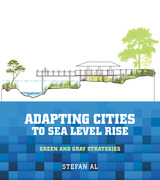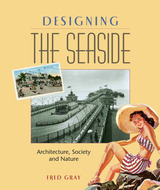
As cities build more flood-management infrastructure to adapt to the effects of a changing climate, they must go beyond short-term flood protection and consider the long-term effects on the community, its environment, economy, and relationship with the water.
Adapting Cities to Sea Level Rise, by infrastructure expert Stefan Al, introduces design responses to sea-level rise, drawing from examples around the globe. Going against standard engineering solutions, Al argues for approaches that are integrated with the public realm, nature-based, and sensitive to local conditions and the community. He features design responses to building resilience that creates new civic assets for cities. For the first time, the possible infrastructure solutions are brought together in a clear and easy-to-read format.
The first part of the book looks at the challenges for cities that have historically faced sea-level rise and flooding issues, and their response in resiliency through urban design. He presents diverse case studies from New Orleans to Ho Chi Minh to Rotterdam, and draws best practices and urban design typologies for the second part of the book.
Part two is a graphic catalogue of best-practices or resilience strategies. These strategies are organized into four categories: hard protect, soft protect, store, and retreat. The benefits and challenges of each strategy are outlined and highlighted by a case study showing where that strategy has been applied.
Any professional or policymaker in coastal areas seeking to protect their communities from the effects of climate change should start with this book. With the right solutions, Al shows, sea-level rise can become an opportunity to improve our urban areas and landscapes, rather than a threat to our communities.

Surprisingly, the common notion of taking a seaside vacation has only existed since the eighteenth century, with a growing acceptance of the idea that fresh air and sea water are good for one’s health. Since then, seaside resorts for all budgets have sprung up around the world. In Designing the Seaside, Fred Gray offers a richly illustrated history of seaside architecture and culture, from the smallest beach hut to the grandest hotels. Through over 400 illustrations that include historic photographs, pamphlets, guidebooks, postcards, and posters, Gray explores the changing attitudes toward shoreline vacations.
“Designing the Seaside manages to be both scholarly and colorful and offers a timely history of seaside art and architecture, from Brighton Pier and beach huts in Nice to a derelict resort complex in the Baltic, to the bizarre Palm islands of Dubai.”—London Evening Standard
“Filled with photographs, architectural drawings, guidebooks, postcards and posters, this book explores changing attitudes to holidays and their settings. . . . There is an exploration of how the seaside became a hotbed for issues of morality, where people took their sauce on a postcard as often as with their fish and chips.”—Daily Telegraph
“Gray’s illuminating study of the history of seaside architecture shows what a profound influence many of the innovations born on British coasts have had on Western holiday ideals.”—Metro London
READERS
Browse our collection.
PUBLISHERS
See BiblioVault's publisher services.
STUDENT SERVICES
Files for college accessibility offices.
UChicago Accessibility Resources
home | accessibility | search | about | contact us
BiblioVault ® 2001 - 2024
The University of Chicago Press









